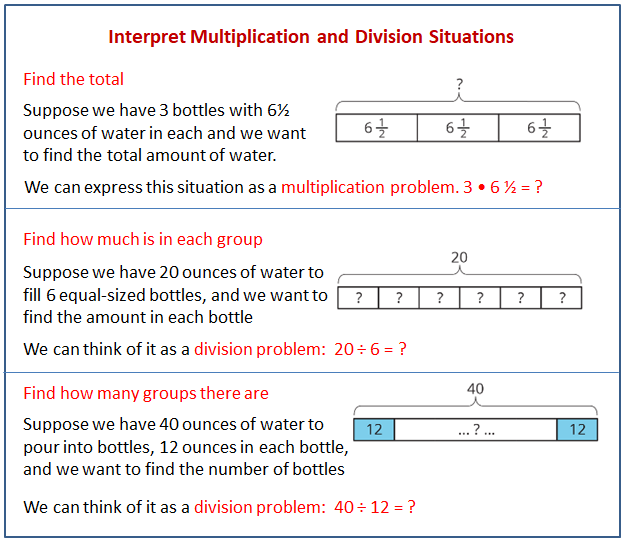Illustrative Mathematics Unit 6.4, Lesson 3: Interpreting Division Situations
Learning Targets:
- I can create a diagram or write an equation that represents division and multiplication questions.
- I can decide whether a division question is asking “how many groups?” or “how many in each group?”
Related Pages
Illustrative Math
Grade 6
Lesson 3: Meanings of Division
Let’s explore situations that involve division.
Illustrative Math Unit 6.4, Lesson 3 (printable worksheets)
Lesson 3 Summary
The following diagram shows how to interpret multiplication and division situations.

Sometimes we want to find the total. Sometimes we want to find how many groups there are. Sometimes we want to find how much is in each group. Anytime we want to find out how many groups there are or how much is in each group, we can represent the situation using division.
Lesson 3.1 Dot Image: Properties of Multiplication
Lesson 3.2 Homemade Jams
Draw a diagram and write a multiplication equation to represent each of the following situations. Then answer the question.
- Mai had 4 jars. In each jar, she put 2¼ cups of homemade blueberry jam. Altogether, how many cups of jam are in the jars?
- Priya filled 5 jars, using a total of 7½ cups of strawberry jam. How many cups of jam are in each jar?
- Han had some jars. He put ¾ cup of grape jam in each jar, using a total of 6¾ cups. How many jars did he fill?
Here is an applet to use if you choose to.
The toolbar includes buttons that represent 1 whole and fractional parts, as shown here. Click a button to choose a quantity, and then click in the work space of the applet window to drop it. When you’re done choosing pieces, use the Move tool (the arrow) to drag them into the jars. You can always go back and get more pieces, or delete them with the Trash Can tool.
The jars in this applet are shown as stacked to make it easier to combine the jam and find out how much you have.
Show Applet
Lesson 3.3 Making Granola
- To make 1 batch of granola, Kiran needs 26 ounces of oats. The only measuring tool he has is a 4-ounce scoop. How many scoops will it take to measure 26 ounces of oats?
a. Will the answer be more than 1 or less than 1?
b. Write a multiplication equation and a division equation that represent this situation. Use “?” to represent the unknown quantity.
c. Find the unknown quantity. If you get stuck, draw a diagram. - The recipe calls for 14 ounces of mixed nuts. To get that amount, Kiran uses 4 bags of mixed nuts.
a. Write a mathematical question that might be asked about this situation.
b. What might the equation 14 ÷ 4 = ? represent in Kiran’s situation?
c. Find the quotient. Show your reasoning. If you get stuck, draw a diagram.
Lesson 3 Practice Problems
- Write a multiplication equation and a division equation that this diagram could represent.
- Mai has $36 to spend on movie tickets. Each movie ticket costs $4.50. How many tickets can she buy?
a. Write a multiplication equation and a division equation to represent this situation.
b. Find the answer. Draw a diagram, if needed.
c. Use the multiplication equation to check your answer. - Kiran said that this diagram can show the solution to 16 ÷ 8 = ? or 16 ÷ 2 = ?, depending on how we think about the equations and the “?”.
Explain or show how Kiran is correct.
- Write a sentence describing a situation that could be represented by the equation 14 ÷ 1 1⅓ = ?.
- Noah said, “When you divide a number by a second number, the result will always be smaller than the first number.”
Jada said, “I think the result could be larger or smaller, depending on the numbers.” Do you agree with Noah or Jada? Show or explain your reasoning. - Mini muffins cost $3.00 per dozen.
- Andre says, “I have $2.00, so I can afford 8 muffins.”
- Elena says, “I want to get 16 muffins, so I’ll need to pay $4.00."
Do you agree with either, both, or neither of them? Explain your reasoning.
- A family has a monthly budget of $2,400. How much money is spent on each category?
a. 44% is spent on housing.
b. 23% is spent on food.
c. 6% is spent on clothing.
d. 17% is spent on transportation.
e. The rest is put into savings.
The Open Up Resources math curriculum is free to download from the Open Up Resources website and is also available from Illustrative Mathematics.
Try out our new and fun Fraction Concoction Game.
Add and subtract fractions to make exciting fraction concoctions following a recipe. There are four levels of difficulty: Easy, medium, hard and insane. Practice the basics of fraction addition and subtraction or challenge yourself with the insane level.

We welcome your feedback, comments and questions about this site or page. Please submit your feedback or enquiries via our Feedback page.


